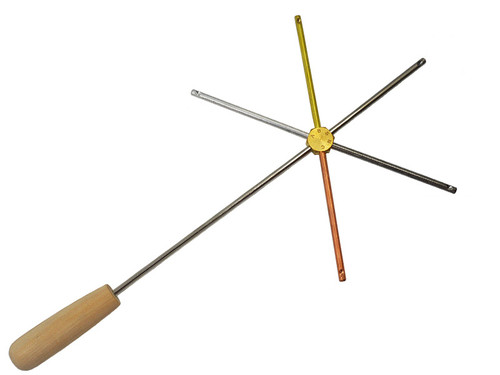Product Overview
The Heat Transfer and Convection Apparatus Set is designed to demonstrate key principles of heat absorption, conduction, and convection in both liquids and gases. This set provides hands-on experiments to engage students and effectively illustrate core concepts in thermodynamics.
Heat Absorption & Radiation Comparator
This Heat Absorption & Radiation Comparator demonstrates the effects of heat absorption and radiation between different surfaces (reflective vs. dull) and compares the heat generation and energy loss of various light bulbs (e.g., LED vs. filament). The apparatus is designed to work with two thermometers (catalog Item No. 28-873000, not included). It operates on a 12 V DC input, which can be supplied by two lantern batteries or a power supply. This setup allows for a visual demonstration of heat efficiency and radiation properties of different materials and light sources.
Heat Conductometer with Wax
The Heat Conductometer with Wax is designed to show the rate of heat conduction through five different metals: Copper, Brass, Steel, Aluminum, and Nickel. Each metal rod extends from a brass hub in a star-shaped configuration, with a cavity at the end for holding paraffin wax (included) or a match head. When the brass hub is heated with a Bunsen flame, the wax melts (or the match head ignites) at different times depending on the thermal conductivity of each metal, offering a clear visual representation of each metal's heat conduction rate. The device is fitted with a steel supporting rod that ends in a wooden handle for easy handling.
Liquids Convection Apparatus
The Liquids Convection Apparatus demonstrates the movement of liquid currents caused by temperature differences. The apparatus consists of a rectangular glass tube (dimensions: 200 × 170 mm, 15 mm O.D.), with an opening at the top for water introduction. A dye or cork dust can be added to the water to make convection currents visible. When the lower part of the tube is heated, convection currents form, and the movement of the dye or cork dust clearly illustrates the process of thermal convection within the liquid.
Gases Convection Apparatus
The Gases Convection Apparatus visually demonstrates convection currents in gases, powered by a candle. Also known as the "convection pinwheel" or "candle-powered pinwheel," the apparatus consists of a chimney (dimensions: 110 × 51 mm), a base (dimensions: 25 × 63 mm), a metal pinwheel assembly, and a candle. When a lit candle is placed under the chimney, the resulting convection current causes the pinwheel to spin. This simple, effective demonstration highlights the movement of warm air caused by the heat from the candle.
Important: Ensure the candle flame does not touch the base or chimney. Operate the apparatus for short periods and never leave it unattended. The metal pinwheel will be very hot after use.







